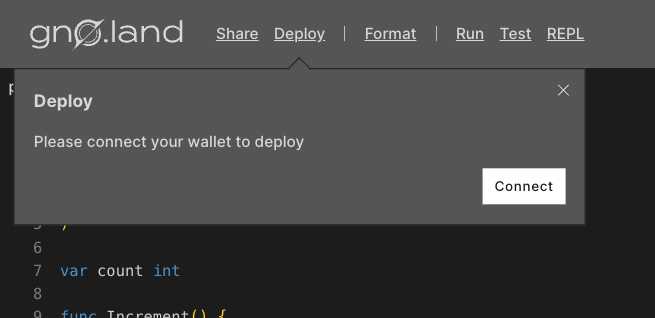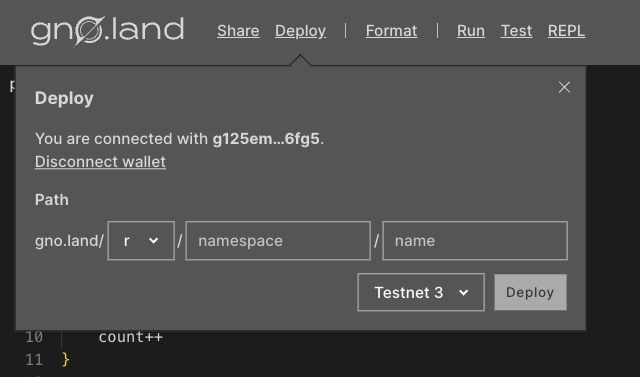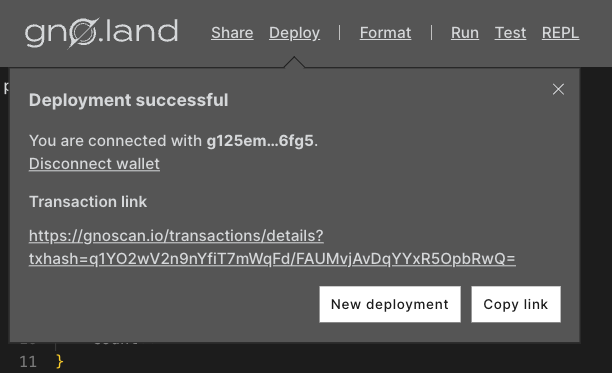How to deploy a Realm / Package
Overview
This guide shows you how to deploy any realm or package to the Gno chain, including how to:
- deploy Gno code in your browser via the Playground,
- deploy Gno code from your local machine using
gnokey'smaketx addpkgAPI.
Deployment via the Playground
Deployment via the Playground is recommended for smaller realms and packages. For larger projects, it is recommended to write, test, and deploy your code from a more appropriate environment, such as a local or online IDE.
For this, check out the Deployment from a local environment section.
Prerequisites
- A gno.land-compatible wallet, such as Adena
Using Gno Playground
To demonstrate deployment using the Playground, we'll use the Counter realm. You can access the sample code via this Playground link.
Review the code and when you're ready, click on "Deploy". Ensure your wallet is connected to proceed. If it isn't, a prompt will appear for connection:

After connecting your wallet to the Playground, you will be prompted with a new toolbox:

Here, you can choose the deployment path of your realm or package, as well as the network to deploy to. The Playground also allows for deployment to a local node if you are running one.
Here are a few things to keep in mind when deploying packages and realms:
- The
namefield in the path should match your package name, in this casecounter. - Packages are deployed under
p/, while realms are deployed underr/.
An example path for the Counter realm could be the following:
gno.land/r/<your_username>/counter
After choosing a path and network, click on Deploy. A pop-up window from your connected wallet will prompt you to sign and approve the deployment transaction.

If all went well, you will have successfully deployed your the Counter package. Congratulations 🎉
Deployment from a local environment
Prerequisites
- Have
gnokeyinstalled - Have access to a
gnolandnode (local or remote) - Have generated a keypair with
gnokey& funded it withgnot - Have a Realm or Package ready to deploy
Deploying
To illustrate deployment, we will use a realm. Consider the following folder structure on a local file system:
counter-app/
├─ r/
│ ├─ counter/
│ │ ├─ counter.gno
We would like to deploy the realm found in counter.gno. To do this, open a
terminal at counter-app/ and use the following gnokey command:
gnokey maketx addpkg \
--pkgpath "gno.land/r/demo/counter" \
--pkgdir "./r/counter" \
--gas-fee 10000000ugnot \
--gas-wanted 800000 \
--broadcast \
--chainid dev \
--remote localhost:26657 \
MyKey
Let's analyze all of the flags in detail:
--pkgpath- path where the package/realm will be placed on-chain--pkgdir- local path where the package/realm is located--gas-wanted- the upper limit for units of gas for the execution of the transaction - similar to Solidity's gas limit--gas-fee- similar to Solidity's gas-price--broadcast- broadcast the transaction on-chain--chain-id- id of the chain to connect to - local or remote--remote-gnolandnode endpoint - local or remoteMyKey- the keypair to use for the transaction
As of October 2023, --gas-fee is fixed to 1gnot (10000000ugnot), with plans
to change it down the line.
Next, confirm the transaction with your keypair passphrase. If deployment was successful, you will be presented with a message similar to the following:
OK!
GAS WANTED: 800000
GAS USED: 775097
Depending on the size of the package/realm, you might need to increase amount
given in the --gas-wanted flag to cover the deployment cost.
Regardless of whether you're deploying a realm or a package, you will be using
gnokey's maketx addpkg - the usage of maketx addpkg in both cases is identical.
To read more about the maketx addpkg
subcommand, view the gnokey reference.
Conclusion
That's it 🎉
You have now successfully deployed a realm/package to a gno.land chain.